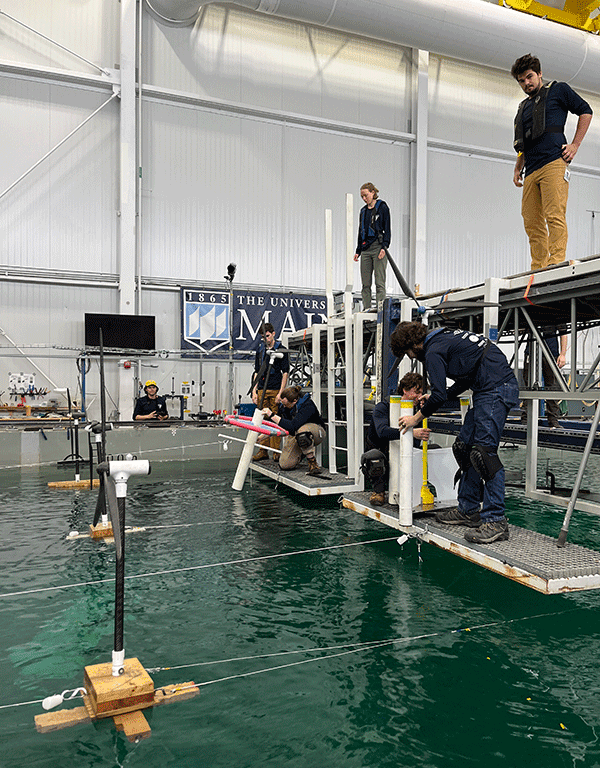Offshore wind holds great promise for Maine. Floating offshore wind in the Gulf of Maine is expected to generate about half of the electricity Maine needs by 2040 by providing a reliable source of renewable energy. This will bring a once-in-a-century opportunity to create good-paying jobs for Maine workers now and into the future.
And there’s more good news: Offshore wind in the Gulf of Maine is coming sooner than you may think.
The federal Bureau of Ocean Energy Management (BOEM) put forward draft leasing areas in the Gulf of Maine in late April and is on track to offer leases for sale by the end of this year. And the Governor’s Energy Office (GEO) has put out a request for information (RFI) asking for input on how Maine will accept bids for offshore wind energy as directed by LD 1895, the landmark 2023 offshore wind bill for which the Natural Resources Council of Maine (NRCM) was a leading voice.
There are more than a hundred occupations in Maine that will be part of developing an offshore wind industry, from engineering and planning, to biologists, legal and business support, and construction and maritime occupations. Overall, if Maine develops an offshore wind port and associated supply chain businesses, offshore wind could create tens of thousands of jobs in Maine.
Leading on offshore wind is a natural continuation of Maine’s centuries-old shipbuilding and maritime heritage. It is an exciting opportunity to build a whole new industry centered on Maine and Maine people, as well as the ingenuity of students and researchers at the University of Maine.
Several recent events underscore what offshore wind could mean for Maine’s workforce, especially giving a younger generation of Mainers the chance to build careers here in the state with good wages and benefits, all while contributing to Maine’s clean energy transition.

Students test their offshore wind models at UMaine's Windstorm Challenge (photo by JCaldwell/NRCM)
On Friday, May 10, NRCM Climate & Clean Energy Outreach Coordinator Josh Caldwell attended the University of Maine’s Windstorm Challenge, where more than 800 middle and high school students competed in teams, bringing their own models of floating offshore wind platforms made entirely from recycled materials. The models were then put to the test in the state-of-the-art wave pool at the UMaine Advanced Structures and Composites Center (ASCC) and graded on performance and a presentation from each team.
The winning middle school Windstorm Challenge team was from the Penobscot Christian School, and the high school winner was a team from Bucksport High School. Students on the high school winning team each got a $20,000 work study scholarship to UMaine to work at the ASCC on offshore wind, and all three are planning to attend UMaine next year. For these students, and for many more in the future, skills developed in high school science classes will directly translate to careers in offshore wind right here in Maine.
In addition to the Windstorm Challenge and their decades in technology leadership developing floating offshore wind technology, the University of Maine is developing curricula specific to offshore wind. Using funding from the Governor’s Energy Office, UMaine is now offering training for careers in the offshore wind industry with new courses, an undergraduate concentration in offshore wind energy, and new micro-credentials.

Scott Cuddy of the Maine Labor Climate Council spoke about offshore wind jobs at a Searsport community meeting (photo by JCaldwell/NRCM)
On Tuesday, May 14, NRCM staff attended an Offshore Wind Workforce Development community event in Searsport. Hosted by the Maine Labor Climate Council, the event covered employment opportunities that will be associated with Maine’s floating offshore wind port.
Because of provisions included in Maine’s 2023 offshore wind bill, jobs building the port and constructing turbines for use far offshore will have high standards for wages and benefits. Unions in Maine provide pre-apprenticeship and apprenticeship programs, allowing people to learn skilled trades while being paid and earning benefits.
One presenter, a union electrician from Rhode Island who worked on two offshore wind projects there, described how good wages from her work in the Port of Providence allowed her to purchase her first home. Another presenter shared that with the amount of floating offshore wind needed in the Gulf of Maine, a worker could “start their career and retire” building offshore wind turbines in Searsport.
Climate change is the biggest threat facing Maine’s coasts, communities, woods, wildlife, and waters. Developing home-grown clean energy sources like floating offshore wind is a key part of Maine’s plan to address it. But offshore wind’s benefits go far beyond the environmental, health, and climate benefits, providing an enormous opportunity to create jobs and economic opportunities for Mainers for generations to come.










Leave a Reply